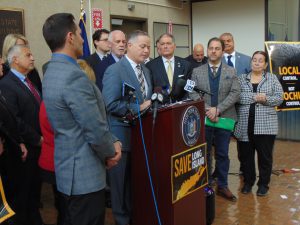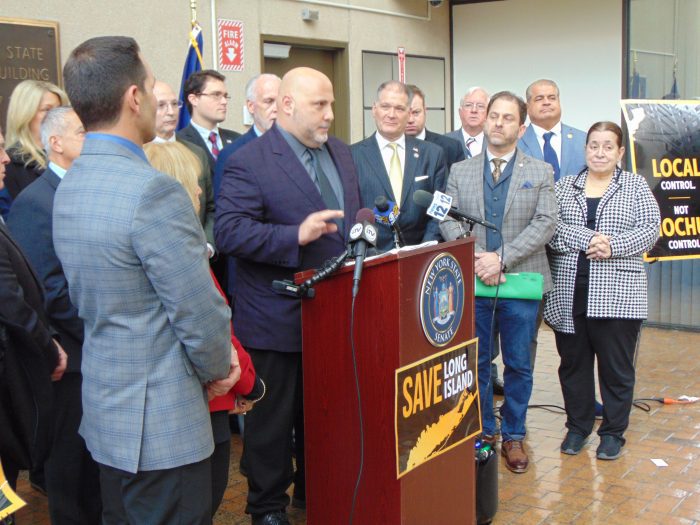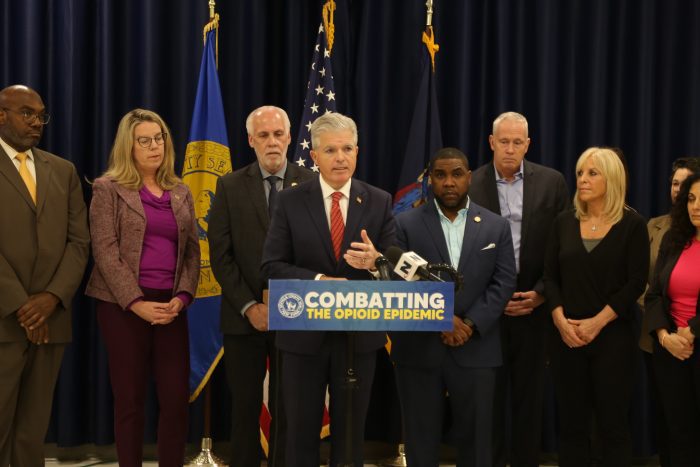Local elected officials held a press conference Friday, Jan. 20, to make it clear that they don’t agree with Gov. Kathy Hochul’s (D) New York Housing Compact proposal.

Republican state senators and assemblymembers, county legislators and town supervisors from Suffolk County gathered at the Perry B. Duryea State Office Building in Hauppauge with a message for Hochul. The elected members speaking at the press conference said zoning, land use and development matters are best left to local elected officials.
In her State of the State message earlier this month, Hochul proposed a housing strategy calling for 800,000 new homes to be built in the state over the course of a decade to address the lack of affordable housing. Among the plan’s requirements would be municipalities with Metropolitan Transportation Authority railroad stations to rezone to make way for higher-density residential development. All downstate cities, towns and villages served by the MTA would have a new home creation target over three years of 3%, compared to upstate counties that would need to build 1% more new homes over the same period.
But speakers on Jan. 20 called her proposed initiative “government overreach” and “misguided,” and they said municipalities should create zoning laws, grant building permits and urban plans based on the individual needs of their communities. Many added that a blanket state housing proposal wouldn’t work on Long Island due to lack of sewer systems, also infrastructure and environmental concerns.
The press conference was led by state Sen. Dean Murray (R-East Patchogue).
“We all agree that we have an affordable housing problem,” he said. “What we don’t agree on is how to fix it.”
He added, “The governor apparently believes that one size fits all is the way to go, that heavy-handed mandates are the way to go.”

Murray said the Village of Patchogue is the model of revitalizing villages and downtowns across the state. He added local issues must be considered, such as environmental concerns, traffic issues and parking options. He said Patchogue officials worked to rebuild the village’s infrastructure, invested in and expanded sewer plants, repaved 85% of its streets, invested into pools, parks and the Patchogue Theatre for the Performing Arts. Murray added 700 new residential homes were built since 2003, 575 of them are within walking distance from the train station and village.
Town supervisors speak up
Town of Brookhaven Supervisor Ed Romaine (R) said they were all concerned about what Long Island will look like in the future. He added there is a need for sewer systems in most towns, and local infrastructure needs improvement. He said the three rail lines that cross the town depend on diesel fuel, and he added overgrowth has also contaminated the waters.
“Governor, before you start talking about more housing, how about the infrastructure to support it?” Romaine said. “How about electrifying the rail? How about making sure the roads work? How about making sure that there are sewers?”
Town of Smithtown Supervisor Ed Wehrheim (R) said the town is manufacturing affordable housing “to the extent it’s possible” based on its infrastructure.
In the last five years, he said the town has approved the construction of 450 rental units, 10% of which are classified as affordable per state law.

“The only elected officials that know how to do that on Long Island are your local elected officials with the help of our county, state and federal officials as well,” Wehrheim said. “So, we are doing what the governor wants, but we’re doing it the right way.”
Town of Huntington Supervisor Ed Smyth (R) said New York politics “is not Republican vs. Democrat. It’s New York City versus New York state.” He said the governor is affected by New York City extremists.
“I implore the governor to form a working coalition of centrist Democrats and centrist Republicans in the state Legislature to govern from the center as the vast majority of New Yorkers expect of you,” Smyth said.
Additional perspectives
State Assemblyman Mike Fitzpatrick (R-St. James) said when he hears the governor talk about local control, he feels she is aligning with the progressive left. He added “everything they touch they destroy,” listing the economy, energy independence and the southern border.
“They want to destroy our local zoning, and they will destroy what makes Long Island and New York state the wonderful place to live that it is,” Fitzpatrick said. “Local control works, and we seek a cooperative relationship, a carrot approach rather than the stick approach that she is putting before us.”
Eric Alexander, director of Vision Long Island, also spoke at the press conference. He acknowledged there is a housing problem on the Island and said the town supervisors have provided hope with past projects.
“They have been behind getting affordable housing in their communities,” Alexander said, adding 20,000 units of multihousing have been approved on Long Island over the past 17 years.
According to Alexander, 10,000 more units are coming down the pike, and 50 communities have had buildings built near transit stations.
State Assemblyman Keith Brown (R-Northport), who has been a zoning attorney for more than 20 years, in an interview after the press conference said incentives and funding are needed.
He said Brookhaven’s Commercial Redevelopment Districts are excellent zoning examples of redevelopment and multifamily houses where there are incentives such as being near transportation and connecting to sewers.

“Those are the incentives that we should be talking about, not creating super zoning boards, and more bureaucracy,” Brown said.
In a statement to TBR News Media, Town of Brookhaven Councilmember Jonathan Kornreich (D-Stony Brook), who was a former president of the Three Village Civic Association, said, “We have to be wise enough to recognize that the land under which our aquifers sit can only bear so much development.”
He gave the example of a parcel of land in Port Jefferson Station on Route 112 and near the train station. The large, vegetated parcel has restrictive covenants to limit the type of development on the site.
“This place is a vital area of green space, where trees can grow, where oxygen is produced and where rainwater is filtered before it goes down to the aquifers we drink from,” he said. “The governor’s proposal would throw all that planning out the window and turn this into a potential development site for hundreds of new units.”
Former state Assemblyman Steve Englebright (D-Setauket), who was chair of the Assembly’s Environmental Conservation Committee between 2015 and 2022, attended the press conference and in a phone interview said, “This is a proposal that attempts to meet one need, but has a likely outcome, if advanced, of completely overriding environmental concerns. Our first limiting factor for sustainable communities is the environment, in particular water — drinking water.”
He added the proposal to increase the density of housing not only overrides local planning but threatens communities’ quality of life.
He added, for example, a village such as Poquott wouldn’t be able to build more housing as it’s “essentially a completely built-out community.” Or, a hamlet such as St. James wouldn’t be able to add more housing near the train station.
“If you impose from above a mandate to change the land use, you’re basically impacting the environment immediately and, for the long term, the quality of life of a community,” he said.
Englebright and current elected officials are concerned that the housing legislation would be included in the state budget similar to bail reform.
Hochul’s administration has said more information on the housing proposal will be released in the near future.
































